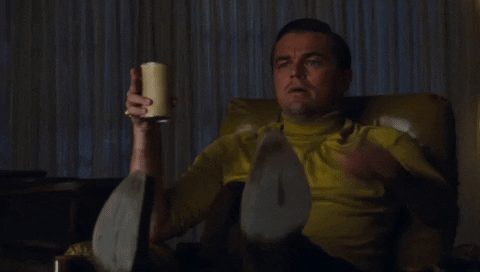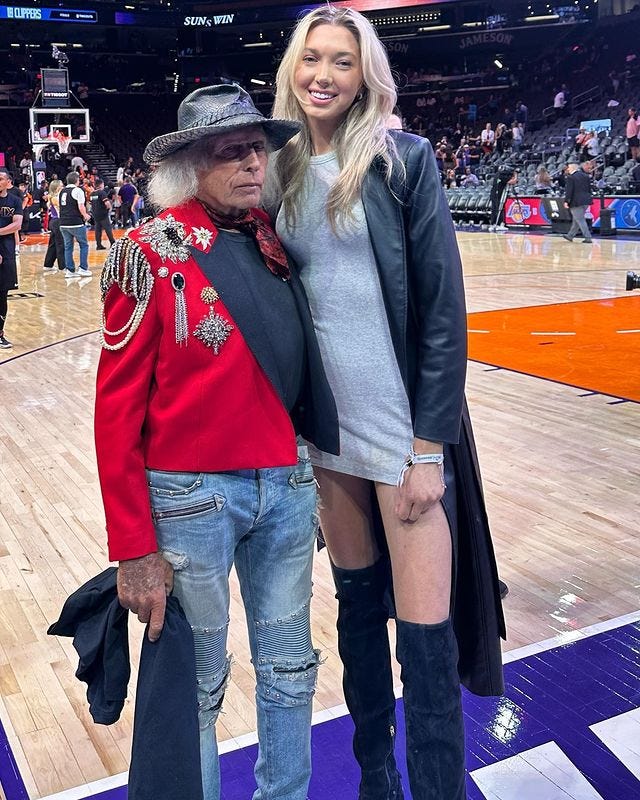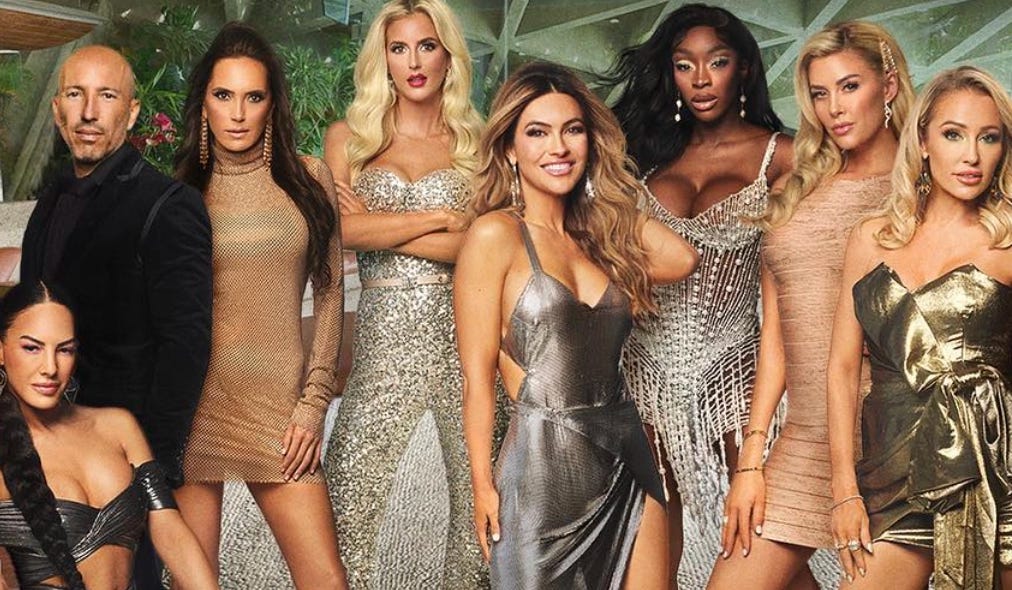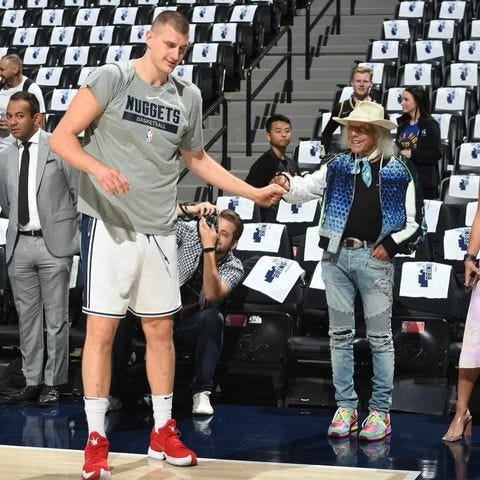The irony of "Selling Sunset" featuring NBA superfan James Goldstein
The reality show takes us to house of the old guy who wears sequins and sits courtside at NBA games — without mentioning how he made his millions
Thank you so much for reading The Wilder Things. If you’ve enjoyed this newsletter so far, please consider becoming a paid subscriber! $5 a month gets you every single newsletter, the ability to comment, and access to the archives. Also —if you get even just three people to subscribe, you get a discount! So smash that subscribe and share button. I am so grateful for your support.
My husband was in a great mood on Monday night because he is hopelessly in love with the Knicks. I know, I know — wouldn’t that usually make a person miserable? On a macro level, yes, but on a micro level, the Knicks had just beaten the Clippers at Madison Square Garden. It was James Harden’s first game as a Clipper and the Knicks’ first home win of the season, making the victory that much sweeter.
So we did what anyone does once a great sports game is over — we put on Selling Sunset. The seventh season of the Netflix reality show dropped a few days ago, and we are parsing it out as a treat, alongside the Reese’s cups we have left over from Halloween.
The second episode ends with the cast gathered at a house designed by John Lautner. Lautner was a disciple of Frank Lloyd Wright and one of the most influential mid-century modern architects of, well, the mid-century. It is a stunning marvel, a mixture of airy glass and grounding concrete poured into a hillside overlooking Los Angeles.
We are told that this house is called the Sheats–Goldstein Residence, and it is owned and occupied by the “very successful businessman” James Goldstein. We see the closet, which is filled with sequins.
And my husband and I suddenly do this.
I didn’t immediately register the name, but I knew there was a reason “James Goldstein” sounded familiar. The clothes gave it away. It’s because this house, dear reader, belongs to one of the NBA’s most famous superfans, Jimmy Goldstein. If you watch the NBA, you’ve probably seen him by the court, wearing a snakeskin cowboy hat and a jacket with lots of fringe and/or sequins. He spends $500,000 per year on courtside seats, looks like a white raisin with a deep tan, and often stands with his fingers hooked into the belt loops of his pants, which are always slung a little too low on his hips.
He is 84 years old now. His Instagram is filled with pictures of him at NBA games, as well as photos of almost naked, or fully naked, young women at his house.
You wanna know how Goldstein got so rich? They won’t tell you this on Selling Sunset, but according to several reports, he makes his fortune by buying mobile home parks and raising rents (sometimes by more than double) on the mostly-senior citizens who already live on the plots of land they lease from the parks. Then, Goldstein sues the cities that oppose his rent hikes.
It’s also worth noting that he paid around $185,000 for his Lautner-designed home in 1972. It is now worth $100 million.
But let me rewind. In the event that you have somehow avoided Selling Sunset, it is a show about realtors who work at the Oppenheim Group, a luxury real estate firm helmed by twins Jason and Brett (you guessed it) Oppenheim. Jason and Brett are very short men who are almost identical. They both have bald heads and biceps so large you’d think they were trying to prove something (they are). The 46-year-old brothers also have a propensity for dating women who are much taller and much younger than they are. I am such a sicko that I can tell Jason and Brett apart the moment one of them appears on screen.
The show revolves around the drama between the realtors, who are all women. They ostensibly sell homes for the Oppenheim Group, but they mostly wear elaborate outfits and fight with each other. The fights have gotten to the point where they don’t even know what they’re fighting about, but a show must have drama.
Especially when the entire point of the show is not to craft cohesive storylines.
It’s to drum up business for Jason and Brett. The twins largely duck out of the drama and leave the dirty work to the women (although the boys have been messier this season!), who yell at each other in conveniently framed shots of the Oppenheim Group’s most expensive listings. The women who subject themselves to this mental warfare profit off of it, too, with social media followings that spawn endorsement deals and levels of fame that propel them to awards shows and other TV opportunities.
My viewing habits are, for better or probably worse, evidence that capitalism dressed up as entertainment works.
Sort of like Goldstein. His house has appeared in a Snoop Dogg music video and in movies like The Big Lebowski. Clothing brands hold photo shoots there. Rihanna had her 27th birthday at the 11,000-square-foot nightclub Goldstein built next to his 5,000-square-foot house (or, as Jason would say, “his only 5,000 square foot house”). According to the Washington Post, Goldstein’s life goal was “to spend as little time as possible working so that I would have the free time to do the things that I really enjoy.”
Goldstein knows how to launder his image using the sports, art, and entertainment industries. In 2021, the Naismith Memorial Basketball Hall of Fame unveiled the James F. Goldstein SuperFan Gallery after Goldstein donated an undisclosed amount of money. The exhibit features some of this perpetual bachelor’s most outrageous and sequin-y jackets. When he dies, his house will go to LACMA. He’s a reverse Robin Hood.
Goldstein and Selling Sunset are a match made in heaven. Throughout this season, Jason, Brett, and their realtors complain bitterly about the “Mansion Tax.” This measure’s official name is the Homelessness and Housing Solutions Tax, or United to House LA (ULA). It puts a 4% charge on all residential and commercial real estate sales in Los Angeles valued above $5 million, and a 5.55% charge on sales above $10 million. The revenue goes towards reducing homelessness and protecting low-income seniors at risk of losing their houses. Jason is quoted in the LA Times as saying the tax is a “travesty.”
There’s something pretty dark about featuring a man who funds his own home by pricing people out of their homes on a show about selling homes (mansions). But I digress.
“John Lautner was very opposed to anything that resembled a box,” Goldstein says in the video above. His house, therefore, has no ninety-degree angles; it is fundamentally opposed to boxes, while Goldstein can afford to live in it because of people living in parks filled with boxed-shaped houses.
Look: the uneasy relationship between commerce and the creation of beautiful things has existed for centuries. Take the Medicis, the rich and corrupt banking family of Italy, without whom we wouldn’t have the Sistine Chapel. Goldstein is the patron of the Lautner house, which, I would argue, is art. Selling Sunset may not be art, but it doesn’t hide what it is — voyeurism on steroids.
It works. Drone shots swoop me into the living room of a home worth the GDP of a small country, and I can’t tear myself away. I want to sit in my rented apartment and judge people for installing black hardware in the bespoke kitchens they own. Images of Italian marble and vast swimming pools plant seductive thoughts of, “what if I could have that?” without asking “at what cost?”
The realtors on the show are, on some level, just answering the siren’s song.
But Goldstein doesn’t play the game, he does something more sinister. He seems to change the rules to fund his massive playground. And he’s found a show that will market — to millions — his desired image of an aging bad boy with mysterious wealth.
Anyway…. go Knicks*.
*just kidding, go Celtics








Great read. You always have a consistent weaving of sports and pop culture with things to ponder.
My goodness your writing takes my breath away. More please.